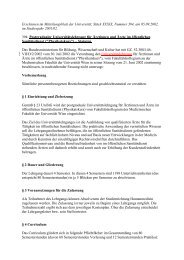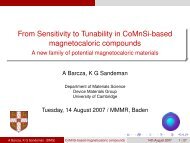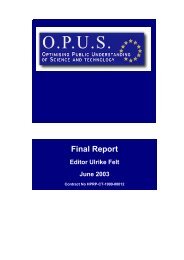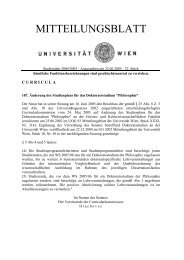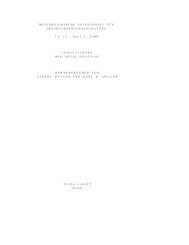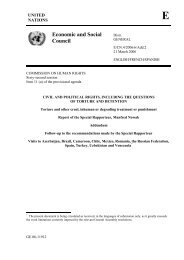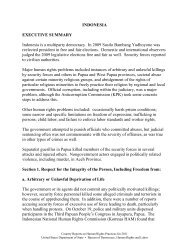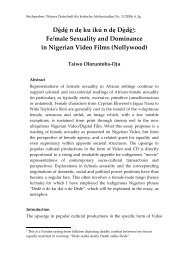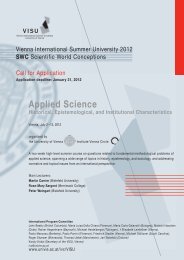(Stand: 25. Juli 2007) ANDERSON, Michael Alan ... - Universität Wien
(Stand: 25. Juli 2007) ANDERSON, Michael Alan ... - Universität Wien
(Stand: 25. Juli 2007) ANDERSON, Michael Alan ... - Universität Wien
Create successful ePaper yourself
Turn your PDF publications into a flip-book with our unique Google optimized e-Paper software.
MEDIEVAL & RENAISSANCE MUSIC CONFERENCE <strong>2007</strong> – WIEN, 7.-11. AUGUST ABSTRACTS<br />
the chanson, and the early history of the Montserrat manuscript makes it possible to suggest<br />
when and where this mass may have been composed. In addition to bringing a previously-unknown<br />
mass based on a little-discussed chanson by a major Renaissance composer<br />
to our attention, this study will refine our knowledge of the practice of polyphonic<br />
borrowing and techniques of canonic writing.<br />
� �<br />
SCHILTZ, Katelijne (Katholieke Universiteit Leuven)<br />
Self-Citation and Self-Promotion: Zarlino and the “Miserere” Tradition<br />
Mittwoch/Wednesday, 8.8., 9.45 Uhr, MuWi, HS 1<br />
Gioseffo Zarlino’s motet collection Modulationes sex vocum (Rampazetto, 1566) contains<br />
two pieces that share a number of characteristics. Not only do they make use of the same<br />
cantus firmus (Ne reminiscaris Domine delicta mea), which is treated canonically, but their<br />
texts are also remarkably similar: Miserere mei Deus and Misereris omnium. Moreover, in<br />
the latter piece, the words Miserere mei Deus pervade the composition as a soggetto ostinato.<br />
Zarlino mentions both motets twice in his Istitutioni harmoniche of 1573 (in the first<br />
edition of 1558, only Miserere mei is cited) and links them explicitly in book 3 (discussion of<br />
contrapuntal techniques) and book 4 (presentation of the modes).<br />
In his studies on Josquin’s Miserere mei Deus, Patrick Macey has investigated the<br />
influence of this composition on Willaert, Rore, Vicentino, and others from an analytical<br />
and historical point of view (see also his dissertation and the monograph Bonfire Songs:<br />
Savonarola’s Musical Legacy, Oxford 1998). Especially their connection with the dukes of<br />
Ferrara provides a common context for this cluster of works.<br />
Interestingly enough, Zarlino’s pair of six-part motets has not been thoroughly<br />
examined as part of this tradition. It is my intention to show that a link with the Este<br />
court can indeed be established. My evidence is based on archival, musical, and theoretical<br />
sources.<br />
� �<br />
SCHMID, Bernhold (Musikhistorische Kommission, Bayer. Akademie der Wissenschaften)<br />
Beati omnes, qui timent Dominum à 5. Oder: Von den Schwierigkeiten, Orlando di Lassos<br />
Motetten zu edieren<br />
Donnerstag/Thursday, 9.8., 11.45 Uhr, MuWi, HS 1<br />
Kein Komponist des 16. Jahrhunderts war zu Lebzeiten weiter verbreitet als Orlando di<br />
Lasso. Aus den Jahren 1555 bis 1687 sind über 470 Einzel- und Sammeldrucke mit seinen ca.<br />
1200 gedruckten Werken erhalten (wohingegen nur ca. 160 Sätze zeitgenössisch ausschließlich<br />
handschriftlich überliefert sind). Einzelne Chansons brachten es auf 30 und<br />
mehr Drucke, und insbesondere die Motetten aus dem „Nürnberger Motettenbuch“ von<br />
1562 sind öfter als 20 Mal gedruckt worden.<br />
- 67 -




